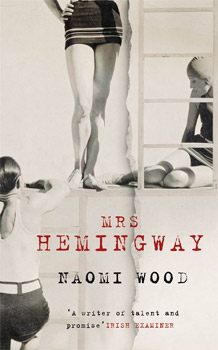Mrs Hemingway

Mrs Hemingway
In the dazzling summer of 1926, Ernest Hemingway and his wife Hadley travel from their home in Paris to a villa in the south of France. They swim, play bridge, drink gin, have parties - and everywhere they go they are accompanied by the glamorous, irrepressible Fife. She is Ernest's lover. Hadley is the first Mrs Hemingway, but neither she nor Fife will be the last. Over the ensuing decades, Ernest's literary career will blaze a trail but threaten to overpower him, and his marriages will be ignited by desire and deceit. Four extraordinary women will learn what it means to love the most famous writer of his generation. Each will see him as no other has before and be forced to ask herself how far she would go to remain his wife... Luminous and intoxicating, Mrs Hemingway smoulders with passion and plumbs the depths of the human heart.
Naomi Wood was born in 1983 and lives in London. She studied at Cambridge and at UEA for her MA in Creative Writing. Originally from York, she has lived in Hong Kong, Paris and Washington DC, and her research for Mrs Hemingway took her from the British Library to the Hemingway archives at universities in Boston and Yale, and to the Hemingway heritage homes in Chicago, Florida and Cuba.
Mrs Hemingway
Macmillan Australia
Author: Naomi Wood
ISBN: 9781447226864
RRP: $34.99
Interview with Naomi Wood
Question: What originally inspired the idea for Mrs Hemingway?
Naomi Wood: I've always been a fan of Hemingway's work, but it was reading his letters that inspired me to write this novel, told from the perspectives of his four wives – Hadley, Pauline, Martha and Mary. The letters are so different from the way he normally writes (none of that terse, tight-lipped prose) and the letters to his wives are even more far removed from the idea we have of Ernest Hemingway as this big man striding around Africa hunting big game, or boxing, or bullfighting, or any of the other stereotypes we have of him! Those letters to the wives – they're so syrupy with so much sentiment and sweet-nothings – they made me think about what he was like as a husband – and that's when I began to think about writing the book.
Question: Was it difficult writing a book set in 1926?
Naomi Wood: Yes! The first part is set in 1926, then as each wife takes the place of the mistress, it's in 1938, 1944, 1961. It was difficult to get the right vocabulary for each era. To accurately describe each landscape (the Hemingways were always globe-trotters and often my wallet couldn't keep up with the travel demands!). To use dialogue in a way that would have been realistic for the characters, I bought lots of different dictionaries to check out when certain words were (and were not) used.
Question: Can you talk about the research involved in writing Mrs Hemingway?
Naomi Wood: I was helped along by the amazing amount of biogaphies that investigate his lives and the wives' lives. I was able to go to a lot of the places I wrote about (Cuba, Key West, Paris, the French Riviera – it was really arduous!) and see first hand where their love affairs flourished, where their arguments exploded, where the mistresses began to appear on the scene. But a lot of the time really was spent in cold libraries – the British Library in London, mostly – with my head in books and boxes trying to find out about as much detail as I could about Mr and Mrs. Hemingway.
Question: What did you enjoy most about writing the characters featured in Mrs Hemingway?
Naomi Wood: I enjoyed very much writing a historical piece and finding out as much as I could about each era. I loved writing about four very different women who were strong and independent but also to some extent in the thrall of this charismatic but bewildering man.
Question: Are you currently working on another book?
Naomi Wood: I'm not yet writing the next one, but I'm having fun writing short-stories and planning for the next one. The next one will be another period piece – I've enjoyed writing historical fiction and doing all the research that I want to do the same again.
MORE



